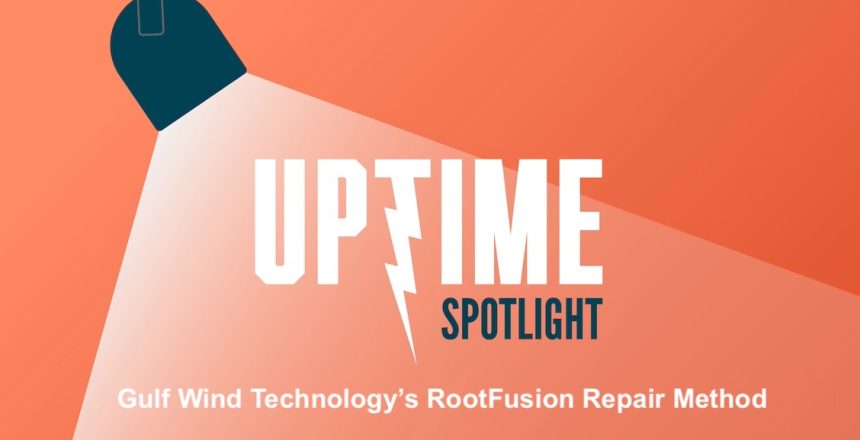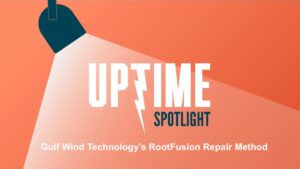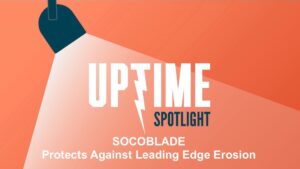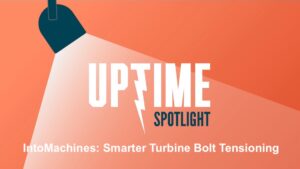If Blade Root Bushing Deterioration keeps you up at night, you might want to get in touch with someone at Gulf Wind Technology. If you think you might have deterioration problems, but they’re in the early stages, then you definitely need to read this or listen to the interview here.
As wind energy continues to scale, operational efficiency and maintenance innovation are critical to maximizing asset lifespan and reducing costs. Recently, we interviewed Gulf Wind Technology CTO David King to learn more about the company’s exciting new solution, RootFusion. The non-invasive, crane-free method for blade root bushing repairs should substantially decrease downtime and repair costs. And with less operational complexity, RootFusion will be a game-changer for technical managers who oversee wind farm assets.
The Problem: Blade Root Bushing Deterioration
The deterioration of blade root bushings has long been a known problem, with no good solution (other than costly replacement).
Bushings are vital for transferring load from the composite blade to the pitch bearing, allowing for blade pitch adjustments and power regulation. Over time, mechanical and chemical breakdowns—due to manufacturing challenges, wear, or environmental factors—lead to loosening connections, visible gaps, dust accumulation, and, in worst cases, blade failure.
The breakdown typically occurs where the metal root bushing interfaces with the composite laminate. The bushing relies on a combination of mechanical compression and chemical bonding within grooves that contain fibers and resin. When this bond weakens, either from manufacturing imperfections, material fatigue, or environmental stressors, then the connection deteriorates and blade integrity is compromised.
The Key: Early Detection
For technical teams, early detection is key to preventing catastrophic failures. Common indicators that blade root bushings are degrading include:
- Dust accumulation around the root area
- Visible gapping or daylight between blade and pitch bearing
- Audible cues during turbine operation
- Visual inspection during routine maintenance
Utilizing non-destructive testing (NDT) techniques, including advanced ultrasonic or visual inspection tools, helps identify early signs of wear – before damage is unrepairable.
The RootFusion Solution: No Crane Needed
Traditionally, repairing or replacing blade root bushings involves complex, costly crane operations, requiring costly turbine downtime and often, logistical headaches. The alternative Gulf Wind Technology’s RootFusion offers is attractive:
- Crane-Free Repair: RootFusion allows for on-site repairs without the need for heavy lifting equipment, significantly reducing operational costs and scheduling constraints.
- Non-Invasive Inspection and Repair: Using sophisticated NDT methods, technicians can assess the condition of the bushing and composite interface without disassembly or invasive procedures.
- Asset Life Extension: By restoring the integrity of the root connection, operators can extend blade life and maintain optimal turbine performance longer – reducing potential warranty hassles in the process.
Strategic Application: When and How to Use RootFusion
Making a decision to employ RootFusion typically involve a comprehensive risk assessment:
- Initial Evalution: Dust, minor gapping, or noise suggest early-stage issues that can be repaired with non-invasive techniques.
- Condition Monitoring: Regular inspections help gauge whether a targeted repair is appropriate, before a full replacement is necessary.
- Operational Goals: Deciding between repair and replacement typically hinges on the turbine’s age, remaining service life, and the operator’s strategic objectives.
The Bigger Picture: Toward a More Competitive Energy Solution
This innovation aligns with industry trends toward predictive maintenance and asset optimization. By enabling quick, cost-effective repairs, Wind farms can reduce downtime, lower O&M costs, and improve overall reliability—key drivers in the competitive energy landscape.
For More Information
Gulf Wind Technology is located in New Orleans, Louisiana. Contact the company at www.gulfwindtechnology.com or email for more information.
This is the “easy read” following the in-depth interview with David King on April 17, 2025. If you’d like to hear three engineers discuss bushing geometry, fiber, resin and weight fraction, listen to the podcast here.
Our Spotlight series features companies whose focus on technologies and business innovations are driving the wind energy industry forward. The interviews are hosted on our podcast page and are available on your favorite listening platform.







